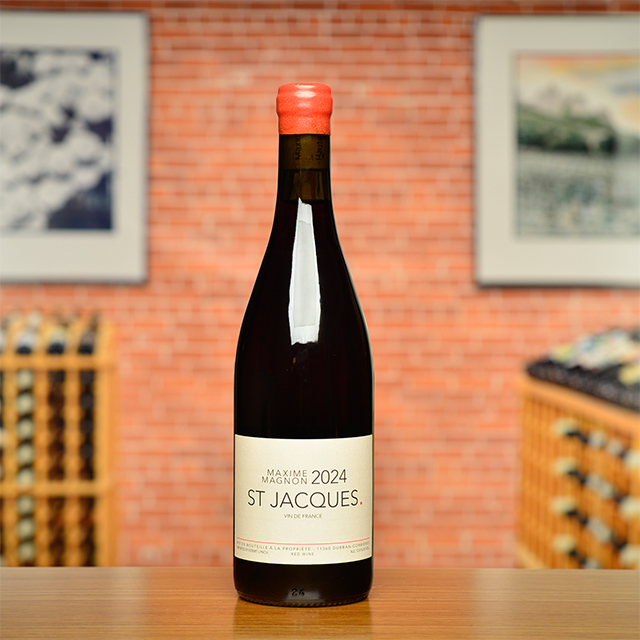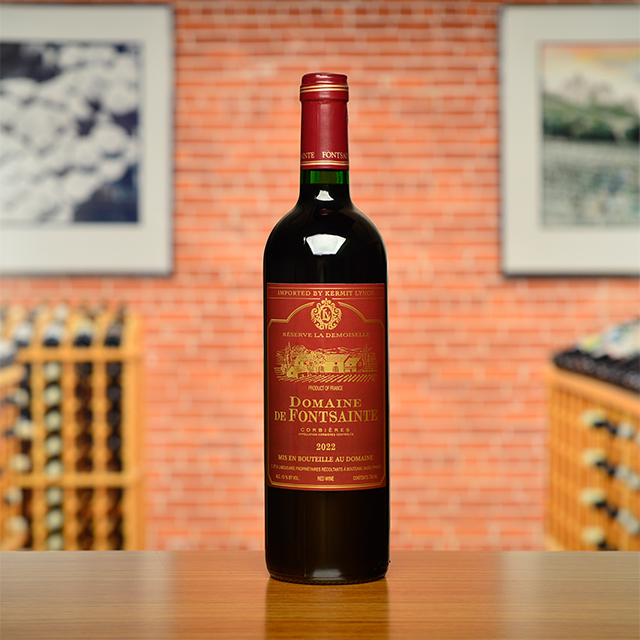Notify me
Value of the Year: An Expat in Pic Saint Loup
Value of the Year: An Expat in Pic Saint Loup
by Anthony Lynch by Anthony Lynch
2019 Pays d’Oc Cabernet Sauvignon “Les Traverses”
2019 Pays d’Oc Cabernet Sauvignon “Les Traverses”


Cyriaque Rozier

Château Fontanès France | Languedoc-Roussillon | Vin de Pays d’Oc
One of the single greatest value reds we import is a pure Cabernet Sauvignon, but not one from the grape’s hallowed homeland of Bordeaux. No, the grape could never make for such a bargain bottling in the land of fancy châteaux, nor express the juiciness, charming rusticity, and completely unfussy nature that it does in the wild countryside of southern France.
Cabernet is a transplant to the sunny Languedoc—one that has proven to work extremely well in the garrigue-saturated limestone rubble that makes up the Pic Saint Loup appellation. This biodynamic rendition is one of the rare expressions of the grape to provide a very elemental form of pleasure, not unlike the feeling of lifting a fistful of sumptuous-looking blackcurrants straight to your face.


Cyriaque Rozier

| Wine Type: | red |
| Vintage: | 2019 |
| Bottle Size: | 750mL |
| Blend: | Cabernet Sauvignon |
| Appellation: | Vin de Pays d’Oc |
| Country: | France |
| Region: | Languedoc-Roussillon |
| Producer: | Château Fontanès |
| Winemaker: | Cyriaque Rozier |
| Vineyard: | Planted in 1970, 1 ha |
| Soil: | Clay, Limestone, Marl |
| Farming: | Organic (practicing) |
| Alcohol: | 14.2% |
More from this Producer or Region

2022 Pic Saint-Loup Rouge
France | Languedoc-Roussillon
Maybe it’s the biodynamic farming, but these wines always seem to have an extra gear when it comes to aromatics and sheer deliciousness.

2021 Monts de la Grage Blanc
France | Languedoc-Roussillon
These ancient hillside vines yield very little, giving an intensely concentrated juice with great acidity and a textured finish. Open it alongside seafood or as an apéritif.

2024 Vin de France Rouge “Saint Jacques”
France | Languedoc-Roussillon
Equal parts Grenache, Carignan, and Mourvèdre, this boasts all of Maxime’s trademark elegance and silkiness.

Banyuls Vinegar
France | Languedoc-Roussillon
This vinegar is particular because it’s made with sweet wine, which confers a very unique taste.

2024 Saint-Chinian Blanc
France | Languedoc-Roussillon
Showcasing impressive texture and flavors of citrus, stone fruit, and spring flowers, this offers a great pairing for grilled fish or seared scallops.

2022 Corbières Blanc “La Bégou”
France | Languedoc-Roussillon
Just different and obscure enough to deliver the thrill of introducing someone to a gorgeous wine that is familiar, but new.

2023 Languedoc Rouge “Lou Maset”
France | Languedoc-Roussillon
A chillable red to accompany anything right off the grill, it is one of our most youthful and exuberant expressions of the Languedoc.

2022 Corbières Rouge “Réserve La Demoiselle”
France | Languedoc-Roussillon
Hailing from the rugged and windswept hills of Corbières, which teem with garrigue and olive groves, La Demoiselle delivers a glorious taste of the South.

2023 Pays d’Oc Cabernet Sauvignon “Les Traverses”
France | Languedoc-Roussillon
Genuinely reflecting the down-home, country soulfulness we love about the Languedoc.

2022 Corbières Rouge
France | Languedoc-Roussillon
A vibrant country red that mixes the trademark notes of the South with beguiling elegance and drinkability.
 /
/
About The Producer
Château Fontanès
About The Region
Languedoc-Roussillon

Ask wine drinkers around the world, and the word “Languedoc” is sure to elicit mixed reactions. On the one hand, the region is still strongly tied to its past as a producer of cheap, insipid bulk wine in the eyes of many consumers. On the other hand, it is the source of countless great values providing affordable everyday pleasure, with an increasing number of higher-end wines capable of rivaling the best from other parts of France.
While there’s no denying the Languedoc’s checkered history, the last two decades have seen a noticeable shift to fine wine, with an emphasis on terroir. Ambitious growers have sought out vineyard sites with poor, well draining soils in hilly zones, curbed back on irrigation and the use of synthetic fertilizers and pesticides, and looked to balance traditional production methods with technological advancements to craft wines with elegance, balance, and a clear sense of place. Today, the overall quality and variety of wines being made in the Languedoc is as high as ever.
Shaped like a crescent hugging the Mediterranean coast, the region boasts an enormous variety of soil types and microclimates depending on elevation, exposition, and relative distance from the coastline and the cooler foothills farther inland. While the warm Mediterranean climate is conducive to the production of reds, there are world-class whites and rosés to be found as well, along with stunning dessert wines revered by connoisseurs for centuries.
More from Languedoc-Roussillon or France
2024 Collioure Blanc “Les Canadells”
Domaine La Tour Vieille France | Languedoc-Roussillon
2022 Languedoc Blanc “Les Cocalières”
Domaine d’Aupilhac France | Languedoc-Roussillon
2021 Pays d’Hérault Rouge
Domaine de la Grange des Pères France | Languedoc-Roussillon
2022 Saint-Chinian Rouge “Sortilège”
Les Eminades France | Languedoc-Roussillon
2018 Vin de France “Grenache Oxydatif”
Domaine Ludovic Engelvin France | Languedoc-Roussillon
2023 Banyuls “Rimage”
Domaine de la Tour Vieille France | Languedoc-Roussillon
2024 Vin de France Blanc “L’Estrade”
Maxime Magnon France | Languedoc-Roussillon
2022 Vin de France Blanc “Malvoise”
Château La Roque France | Languedoc-Roussillon
2022 Languedoc Montpeyroux Rouge
Domaine d’Aupilhac France | Languedoc-Roussillon
2022 Vin de France Blanc de Voile
Ludovic Engelvin France | Languedoc-Roussillon
2019 Faugères “Valinière”
Domaine Leon Barral France | Languedoc-Roussillon
2022 Corbières Rouge “Réserve La Demoiselle”
Domaine de Fontsainte France | Languedoc-Roussillon
2024 Collioure Blanc “Les Canadells”
Domaine La Tour Vieille France | Languedoc-Roussillon
2022 Languedoc Blanc “Les Cocalières”
Domaine d’Aupilhac France | Languedoc-Roussillon
2021 Pays d’Hérault Rouge
Domaine de la Grange des Pères France | Languedoc-Roussillon
2022 Saint-Chinian Rouge “Sortilège”
Les Eminades France | Languedoc-Roussillon
2018 Vin de France “Grenache Oxydatif”
Domaine Ludovic Engelvin France | Languedoc-Roussillon
2023 Banyuls “Rimage”
Domaine de la Tour Vieille France | Languedoc-Roussillon
2024 Vin de France Blanc “L’Estrade”
Maxime Magnon France | Languedoc-Roussillon
2022 Vin de France Blanc “Malvoise”
Château La Roque France | Languedoc-Roussillon
2022 Languedoc Montpeyroux Rouge
Domaine d’Aupilhac France | Languedoc-Roussillon
2022 Vin de France Blanc de Voile
Ludovic Engelvin France | Languedoc-Roussillon
2019 Faugères “Valinière”
Domaine Leon Barral France | Languedoc-Roussillon
2022 Corbières Rouge “Réserve La Demoiselle”
Domaine de Fontsainte France | Languedoc-Roussillon
Kermit once said...

Kermit once said...
You don’t have to be rich to cellar a great wine.














